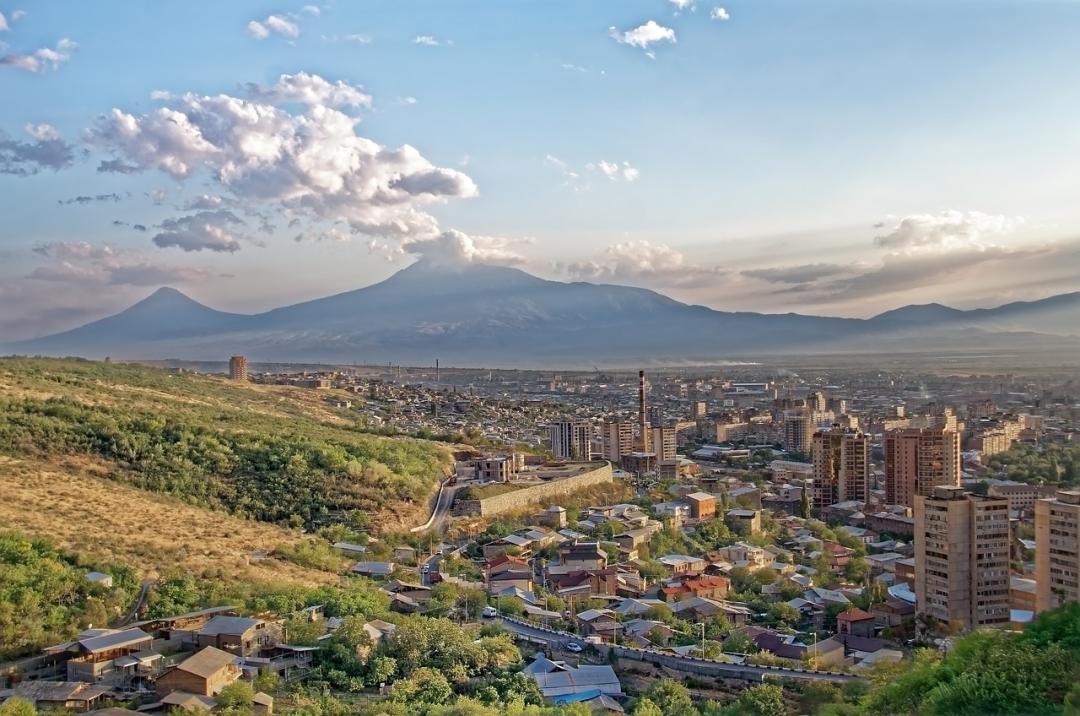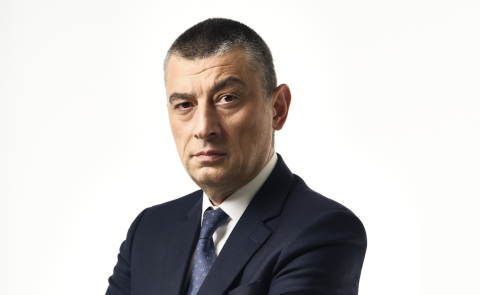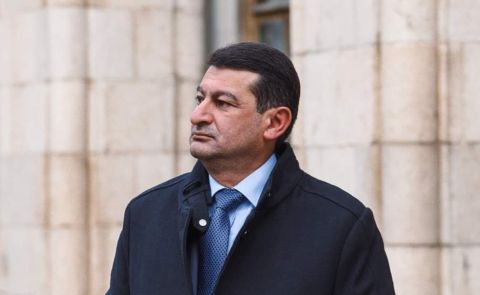
Vardan Aramyan: “In Armenia, Geoeconomics Triumphs Over Geopolitics”

The Caucasus is at the nexus of global governance transformations. Western sanctions have redirected Russian supply chains, resulting in a net benefit for the region. Turkey, Georgia, Armenia, Iran, and Azerbaijan have seen economic benefits, including preferential access to a vast market and cheap energy. Russia is rediscovering the benefits of soft power. The Kremlin is increasing its economic influence, even as its military grip over the region looks far less resolute.
Armenia is now experiencing typical political and economic friction. According to reports, Yerevan is becoming closer to Russia economically but is politically straying from it. Caucasus Watch seeks to explore the friction between geopolitics and geoeconomics in Armenia, starting with a conversation with Vardan Aramyan. Mr. Aramyan is a key figure in Armenian economic governance. For more than a decade, he served in various roles in the Central Bank (1999-2008) and the Ministry of Finance, serving as Minister (2016-2018) and Deputy Minister (2008-2013).
For the best part of two decades, he has liaised with international institutions – the World Bank, the International Monetary Fund, the European Bank for Reconstruction and Development, and the Black Sea Trade and Development Bank – supporting Armenia’s global economic governance. He is now Vice President of the Vallex Group, a managing partner of the financial consulting firm VV&Partners, and continues to be in tune with markets and credit risks. Together we explore continuity and change.
I wanted to look a bit beyond the horizon of current affairs. The size of Armenia’s economy has trebled since the devastating 2020 war with Azerbaijan. In December 2023, the country saw its first trade surplus in over a decade, even if short-lived. The Dram has appreciated, and the Central Bank of Armenia is beginning to subdue interest rates. In terms of concrete numbers, is there any macroeconomic indicator that could spoil this rosy picture?
As you said, this does look rosy. A helicopter view of the Armenian economy indicates a flourishing economy with double-digit growth in 2022 (12.6%), an 8.3% growth in 2023, and we are likely to close this year at 6%. So, not bad at all as the global economy is slowing down. That is impressive.
On closer inspection, the fundamentals underpinning growth still present challenges. In academic literature, one can meet two types of growth models that are usually discussed: supply push, when growth stems from qualitative changes in supply, such as productivity gains, or demand-pull, when external financial flows temporarily flood the local economy, fueling demand and consumption. Armenia’s current growth is demand pull type or is based on external factors that suddenly created a spur of demand for Armenian goods and services.
That is not sustainable growth, as it is not driven by the surge of local productivity. This kind of demand-driven economic growth model is not unprecedented either in Armenia or the region at large. From 2002 to 2008, we had a sudden burst in demand benefi ting Armenia, Azerbaijan, Georgia, or Moldova. In the early 2000s, this was driven by the Federal Reserve’s expansionary monetary policy, followed by the financial markets reaction. As a result, significant financial inflows emerged in these countries, causing their economies to overheat. We are witnessing a similar situation now; despite the underlying causes for these financial inflows being different, they have led to a similar phenomenon—financial inflows through various channels, fueling economic growth via a demand-pull model. The latest economic uptick is triggered by the Russo-Ukrainian conflict.
The problem with this type of growth is that non-tradable sectors – services, trade, residential construction – are typically the first to benefit from sudden substantial financial inflows. This stifles the tradable sector as the exchange rate begins to appreciate, diverting capital from productive investment. Because the tradable sector is the backbone of the economy, these tendencies diminish the resilience of economies. When those financial inflows slow, stop, or reverse, the economy struggles to sustain growth. Let’s look at the figures: From 2018 to 2023, Armenia's average GDP growth was around 5.5%. Of these, the tradable sector (industry, agriculture, information technologies, and telecommunications (ITC)), contributes only 0.8 percentage points. In the years 2022-2023, following the onset of the Russian-Ukrainian conflict, the average growth was 10.7%, with the tradable sector contributing only 1.5 percentage points.
In such an economic environment, there are some macro indicators that we must closely monitor: the first indicator to watch is unemployment. When you improve supply factors and support a country's global exports of goods and services, you create a resilient labour market. When the tradable sector drives sustainable economic growth, the resilience of the labour market increases. To the contrary, financial inflows that bolster short-term demand and drive growth in the non-tradable sector create employment, as this part of the economy is traditionally labour-intensive. Similarly, in Armenia, we have observed a dramatic reduction in unemployment in recent years, from 18.2% to 12.6%. However, if these financial inflows cease, leading to stagnation or decline in the non-tradable sector, the unemployment rate is likely to reverse as well.
The second indicator to monitor is the composition of the banking lending portfolio. As of June 2024, almost half of the banking loans to the economy in Armenia (48%) were to households in the form of consumer credits and mortgages. This is a big risk, given a shallow labor market and a volatile economy. As most labour is not tied to the trad able sector, when financial flows reverse, they could go really bad for a number of households really quickly, putting also banks in the red.
From 2018 to date, there has been a 64% increase in nominal wages. That is an average of 11.5% a year, which also sounds impressive and could be seen as good news from the perspective of households’ ability to service their debt. However, we know that the world, including Armenia, entered a period of high inflation after 2020, resulting in real wages growing by only about 4.6% per year on average. That is substantially lower than the growth of household consumption credits and mortgages. Additionally, the significant improvement in tax collections and tax compliance in Armenia since 2018 partly explains the high nominal wage growth rate, as many salaries have started to be officially recorded. So, wage growth is timid, and that is concerning.
The good news is that since 2018, tax receipts have surged, and we have more resources in the budget to affect real change. That is significant because it shows that not all growth remains in the informal economy. But it’s not enough, and we need to be more resolute in our policy. Since 2022, it was clear that, in the context of the Russian-Ukrainian conflict, financial inflows to Armenia and other countries in the region would increase through various channels, such as the influx of people, the migration of companies, increased remittances, re-exports, and more. In this situation, economic policy needed to be proactive y changing the structure of taxation to aggressively tax the flourishing non-tradable sector and redirecting capital to the exportable sector, which was facing hurdles due to an appreciating exchange rate and declining profitability.
A sudden capital inflow from relocating Russian businesses, largely due to the war in Ukraine, fuelled the growth of the Armenian economy. Perhaps as significantly, this capital inflow came hand in hand with the migration of a highly qualified workforce, fueling Armenia’s growth as an IT hub. Would it be fair to say that the war in Ukraine has benefitted the Armenian economy?
In short, the answer is yes, but let’s see what happened since 2022 and try to place our own lived experience in an international context. The first thing we need to do is to distinguish between firms and households of the conflicting states, as their motives to send money or migrate in such a difficult situation differ. Understanding the motivation behind these flows determines whether the benefits are long-term or short-term.
For the households, the first motive is to seek safety. Households affected by the conflict always look for a safe haven. The first wave of people coming to Armenia were not tourists, and they came with more money in their pockets compared to the regular tourists. Both Russians and Ukrainians have migrated to Armenia, Georgia, Moldova, and Kazakhstan. They seek peace and stability. Among these migrants, there were many IT specialists. This happened also elsewhere, including the Middle East. As soon as there is a conflict, safety is a major factor, as they need to escape danger. The second motive for the households is asset diversification. Even those who are not immediately threatened by war want to make sure they can use their savings in the future, shielding themselves from the threat of capital controls that states embroiled in conflict often impose to reduce capital outflow. Households want to make sure they have access to their savings, so they need to diversify where they hold them. A bank account in Georgia or Armenia is a good “insurance” policy. This motive grows stronger, driving the behaviour of households in the face of imposed sanctions on the Russian economy, particularly in the financial sector.
For businesses, the key motive is ensuring business continuity, which becomes more salient in the face of Russian sanctions. The way to achieve this depends on the sector to which the business belongs. Businesses in certain sectors, like communications or software development, are more mobile, so they mainly choose to migrate or redomicile to other countries. You cannot see construction or heavy industry companies moving, so usually they limit themselves to opening bank accounts for Special Purpose Vehicles to circumvent sanctions. So, knowledge or technology intensive industries are more likely to redomicile.
IT-based Russian or Ukrainian firms chose Armenia due to its favourable taxation for IT start-ups and income-tax breaks for professionals settling there. For instance, the normal personal income tax rate is 20%, and the IT sector stands at 10%. Profits are tax-exempt. These are major incentives. In addition, the ease of doing business in Armenia is competitive not only in a regional framework but also globally. Armenia is evidently a more secure business environment. That remains an obvious incentive. Of course, Armenia does not have the size of the economy required to compete with the United Arab Emirates or Kazakhstan, but we have historically performed well in the World Bank’s Ease of Doing Business Index, like Georgia, and we have successfully fought petty corruption.
Again, none of that is unprecedented. This reminds me of how Israel capitalised on the collapse of the USSR in the 1990s, hosting highly qualified professionals, mathematicians, mechanics, technicians, and others.
Now the challenge for us is to keep the firms and the professionals. Currently, the government is drafting a new strategy in that respect. There are also other cultural factors that affect Russian or Ukrainian-origin IT specialists to choose Armenia to stay in the long run. First of all, most Armenians speak Russian. My generation was raised in the USSR, so it goes without saying. The Russian language also enjoys a high status even in public administration, as official communication within the Eurasian Economic Union is carried out in Russian. We don’t have linguistic or, more broadly, cultural barriers. That is a competitive advantage, as most Russians do not speak Arabic. Secondly, we invested in education to strengthen the technical knowledge of the younger generation. For instance, we introduced chess as an obligatory subject in schools. There is a correlation: good chess players tend to excel in mathematics and physics, and we have certain competitive advantages in terms of a growing competitive workforce for the IT sector.
However, it remains the case that Russia is Armenia’s biggest trading partner. Even the surge of trade with other partners, such as the UAE, is arguably linked to the surging significance of the Eurasian Customs Union. Russia is also a strategic investor in energy and transport infrastructure. Is a multi-vector foreign policy economically viable? For instance, could Yerevan leave the CSTO while remaining a member of the Eurasian Customs Union?
Figures don’t lie. Armenia’s trade turnover in 2018 was $7.4 billion, of which $1.9bn was trade with Russia, $1.8 billion with the EU, and around $200 million with the US. Still, that was roughly balanced between North-East and West.
Fast forward to 2023, and we have a picture of singular dependency on Russia. The good news is that our trade turnover grew substantially to $20,7 billion. Trade with Russia had a turnover of $7,3 billion. It more than trebled. Trade with the EU gives us a turnover of $2,6 billion, which is a far less significant surge. Trade with the US has reached around $700 million, trebling but not gaining significant traction. The only significant difference is the entry of the United Arab Emirates as a significant trade partner, a capital flow exclusively linked to re-exporting commodities from Russia. That accounts for $2,3 billion compared to the 2018 figure of 180 million, which means dependency on Russia is far more significant and imbalanced.
If you look at exports, the dependency on Russia is really overwhelming. In value terms, Armenia exported goods and services valued at $2,4 billion in 2018. This was balanced to $700 million to Russia, $700 to the EU, $50 million to the US, and about $10 million to the UAE.
Again, the good news is that the value of our exports has surged. However, there is a singular dependency on Russia. In 2023, our exports quadrupled to $8,4 billion. Russia holds more than 40% share ($3,4 billion ), to which you can add the effect of $2,2 billion headed towards the UAE, mainly of gold. Exports to the EU amount to $0,7 billion, while exports to the US have not significantly surpassed 2018 levels. Unfortunately, our dependency on Russia has increased. Similarly, foreign direct investment flows from the West are nowhere nearly as competitive as capital inflows from Russia.
The EU has pledged 270 million euros over four years. For comparison, Brussels committed to 4 billion euros in 2009, or inflation adjusted roughly 6 billion in today’s money for Georgia. In relative terms, the EU’s commitment to Armenia is not as significant as required to compensate for the possible negative effects reorienting the market to the west and fundamentally affect the country’s market orientation. For instance, within a year, a theoretical 10% decline in the exports to Russia will cost the Armenian economy a 360 million forex loss, which is higher than the annual receipt from the pledged 270 million euros. That amount is insufficient even to cover budget expenses for the Artsakh (Nagorno-Karabakh) refugees. Armenia needs to spend over $250 million annually in social transfers and housing support for the Armenian refugees from Nagorno-Karabakh, from where they had to flee, as Baku forced the indigenous population to flee, disrupting 3,000 years of continuous presence in the region. International partners have pledged a couple of million dollars to support the victims of this ethnic cleansing campaign.
Coming back to the fundamental question: Armenia cannot sacrifice membership in the Eurasian Customs Union. There is no economic partner that can measure up to or aspires to measure up to Russia, and that is unfortunate. I am not even entering into this equation the significance of natural gas import prices or the significance of Russia Armenian temporary workers’ remittances.
Talking about difficult but indispensable partners, do you fear the repercussions of a war in the Middle East, including Iran?
The effects of conflict are increasingly globalised. You see this in Suez, which had an impact on increasing logistic prices. The closer you are to a conflict region, the bigger the effect. However, the blockage of the Suez Canal has added to global inflationary pressure as the cost of logistics surges.
Iran is our neighbour but also a vital transit partner. There is no major conflict yet, but Iran and Georgia are Armenia’s sole access routes to the global economy. Because Turkey and Azerbaijan retain their borders closed, people and goods can access global markets via Iran or Russia. One cannot overstate how important the roads via Iran are. If Iran closes, we will only have access to Georgia. Only one breathing tube will remain. That is dangerous.
If you think of the security framework in which the Armenian economy evolves, are you optimistic or pessimistic? Armenia is a small country of less than four million people with about five unicorns, IT companies with capitalisations over $1 billion. Is that the future?
Armenia has vulnerabilities. There are factors beyond our control. What Russia, Iran, the West, or Turkey will do is not in our hands. The question is, what can we do?
We have learned to work with blockades as 73% of our borderline is sealed off. Azerbaijan and Turkey want us out of the Caucasus.
We need to think of knowledge-intensive sectors that increase the quality of our labour market and have multiplier effects for our economy. Clearly, the IT sector will be a solid foundation. The government develops a number of policies designed to support this sector. We have a range of incentives to attract talent and firms, and we have reigned over petty corruption.
We have and continue to develop techno-centres, IT incubators, engineering cities, and we are investing in education. Armenian talent is notable. Geopolitics is the main concern, but we do what is in our hands.
Interview conducted by Ilya Roubanis
See Also


Irina Mamulashvili: Electoral Interference is a Playbook, not a Recipe

Giorgi Gakharia: The EU Should Engage Georgia Despite Its Democratic Backsliding

Peace or Capitulation? Shahverdyan on Armenia-Azerbaijan Agreement and the Nagorno-Karabakh Crisis

Ali Mousavi Khalkhali: Iran Will Avoid Conflict in the Caucasus

